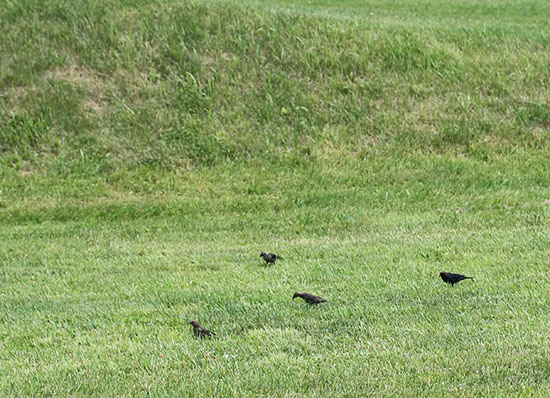Issue 8, June 14, 2016
Sod Webworm
The hot, dry weather we are experiencing is conducive for sod webworms in non-irrigated turf. High temperatures result in shorter generation times, allowing more generations and higher population numbers. Dry soils reduce the infection rate of naturally-occurring microsporidia that usually help keep larval numbers low. All of this allows more individuals to mature faster resulting in high sod webworm numbers.
Adult sod webworm moths have light tan wings that are held tight against the body, giving the body a tube-like appearance. Their mouthparts have long palps that protrude beyond the front of the head, resulting in they and relatives having the common name, snout moths. The species vary in size from one-half inch to about one inch long, and some species have whitish or brown stripes on their wings. When these moths are disturbed during the day in turf, they fly low to the ground, no higher than your head, in a jerky fashion. They do not fly very far, settling back down onto the turf within about 30 feet of where they were disturbed. The most common species, the larger sod webworm, tends to sit crosswise on the grass blade when at rest. Other species sit lengthwise on the grass blades.
Eggs are dropped into the turf as the adult moths fly across it. The resulting larvae live in a silk-lined tunnel in the thatch during the day, coming out at night to clip off and eat the grass blades. Small balls of green fecal pellets are common around the crowns of infested turf. The larvae are slender with dark brown spots. Their base color may be whitish, gray, tan, or green depending on the species and the larval feeding activity. Fully-grown larvae of the larger sod webworm are about one inch long. Other species are similar in size or smaller.
Damage first appears as indistinct brown patches of turf. Close examination will reveal that most of the grass blades are missing with the thatch causing the brown appearance. The turf will be firmly rooted. As infestations progress, entire lawns can turn brown.
Sod webworm caterpillars in infested lawns typically attract insect-feeding birds such as starlings, brown-headed cowbirds, red-winged blackbirds, and robins. In the photo, brownish patches caused by sod webworm are present around the feeding brown-headed cowbirds and on the slope behind them. Realize that insectivorous birds also feed on other insects in the turf. Their presence indicates that the turf should be scouted for sod webworms.

Sod webworm damage and brown-headed cowbirds
Unwatered turf in areas with drought is likely to experience high amounts of sod webworm larval damage. If unattended, large turf areas are likely to die. If infestations are noticed early and promptly treated, the intact root system will quickly replace the eaten grass blades, resulting in quick recovery of the turf's appearance.
Sod webworms are easily controlled with many insecticides. Effective, labeled products include bifenthrin (Onyx, Talstar), carbaryl (Sevin), chlorantroniliprole (Acelepryn), clothianidin (Arena), deltamethrin (Delta Gard), indoxacarb (Provaunt), lambda-cyhalothrin (Scimitar), trichlorfon (Dylox), spinosad (Conserve), and Steinernema carpocapsae (Biosafe). The last two are considered to be organic. Allow the spray to dry on the grass blades. (Phil Nixon)
Author:
Phil Nixon